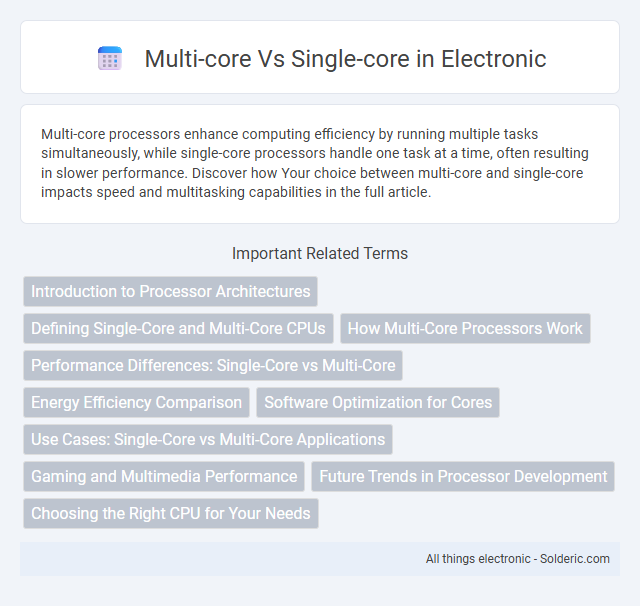Multi-core processors enhance computing efficiency by running multiple tasks simultaneously, while single-core processors handle one task at a time, often resulting in slower performance. Discover how Your choice between multi-core and single-core impacts speed and multitasking capabilities in the full article.
Comparison Table
| Feature | Multi-Core Processor | Single-Core Processor |
|---|---|---|
| Number of Cores | Multiple cores (2 or more) | One core |
| Performance | Higher parallel processing, better multitasking | Limited to single-thread performance |
| Power Consumption | More efficient with tasks spread across cores | Lower overall power, but less efficient for heavy workloads |
| Heat Production | Potentially higher heat due to multiple cores | Lower heat output |
| Use Case | Gaming, video editing, heavy multitasking, servers | Basic computing, simple applications |
| Cost | Generally higher due to complex architecture | Typically lower price |
| Software Support | Requires software optimized for multi-threading | Works with all legacy single-thread applications |
Introduction to Processor Architectures
Multi-core processors integrate multiple processing units (cores) on a single chip, enhancing parallel computing capabilities and improving overall system performance compared to single-core processors. Single-core processors handle one task at a time, limiting multitasking efficiency and throughput in modern applications. Your choice between multi-core and single-core architectures impacts computing speed, power consumption, and the ability to run complex or simultaneous tasks efficiently.
Defining Single-Core and Multi-Core CPUs
Single-core CPUs contain a single processing unit that executes one task at a time, limiting the ability to handle multiple processes simultaneously. Multi-core CPUs integrate two or more processing units (cores) on a single chip, enhancing performance by running parallel tasks efficiently. Understanding the difference between single-core and multi-core CPUs helps you select the best processor for your computing needs, balancing speed and multitasking capabilities.
How Multi-Core Processors Work
Multi-core processors operate by integrating two or more independent cores within a single chip, allowing simultaneous execution of multiple tasks and improving overall computing efficiency. Each core can handle its own thread, enabling parallel processing that significantly enhances performance for multitasking and complex applications. Your system benefits from reduced latency and faster processing speeds as multi-core technology distributes workloads across cores, minimizing bottlenecks seen in single-core processors.
Performance Differences: Single-Core vs Multi-Core
Multi-core processors significantly enhance performance by distributing tasks across multiple cores, enabling parallel processing and faster execution of complex applications compared to single-core processors that handle one task at a time. Single-core CPUs often face bottlenecks in multitasking and high-demand workloads, whereas multi-core CPUs improve responsiveness and efficiency in multi-threaded programs and modern software environments. Performance gains in multi-core systems are particularly noticeable in gaming, video editing, and large-scale computations, where concurrent processing maximizes CPU utilization.
Energy Efficiency Comparison
Multi-core processors achieve superior energy efficiency compared to single-core CPUs by distributing workloads across multiple cores, reducing the need for high clock speeds and lowering overall power consumption. This parallel processing approach minimizes thermal output and extends battery life in mobile devices. Energy savings from multi-core designs enable more sustainable computing while maintaining high performance for complex applications.
Software Optimization for Cores
Multi-core processors enable software optimization by allowing parallel execution of tasks, significantly enhancing performance for applications designed to utilize multiple threads. Single-core processors rely heavily on software efficiency within a single thread, often leading to bottlenecks in multitasking environments. Your software's ability to leverage multi-core architectures can dramatically improve processing speed and responsiveness.
Use Cases: Single-Core vs Multi-Core Applications
Single-core processors are ideal for simple tasks and legacy applications that do not require parallel processing, such as basic word processing or older embedded systems. Multi-core processors excel in multitasking environments and resource-intensive applications like video editing, 3D rendering, and gaming, where parallel processing significantly enhances performance. Developers optimize software for multi-core architectures to achieve faster execution and improved efficiency in workloads such as machine learning and data analysis.
Gaming and Multimedia Performance
Multi-core processors significantly enhance gaming and multimedia performance by enabling parallel processing of complex tasks, resulting in smoother gameplay and faster rendering times. Games optimized for multi-threading leverage multiple cores to handle AI, physics, and background processes efficiently, reducing lag and improving frame rates. Single-core processors struggle with modern gaming demands and multimedia editing due to limited parallel processing capabilities, often causing slower performance and longer load times.
Future Trends in Processor Development
Future trends in processor development emphasize the shift towards multi-core architectures to enhance parallel processing capabilities and energy efficiency. Advanced manufacturing processes like 3nm and below enable more cores per chip without significantly increasing power consumption or heat output. Emerging technologies, such as heterogeneous multi-core designs and AI-optimized processors, are driving improved computational performance for diverse applications ranging from mobile devices to data centers.
Choosing the Right CPU for Your Needs
Selecting the right CPU involves evaluating the core count based on your workload requirements; multi-core processors excel at multitasking and parallel processing, making them ideal for gaming, video editing, and complex simulations. Single-core CPUs may suffice for basic computing tasks like web browsing and office applications, offering simpler architecture with potentially higher clock speeds per core. Understanding these performance differences ensures optimal CPU choice aligned with your software demands and budget constraints.
multi-core vs single-core Infographic

 solderic.com
solderic.com